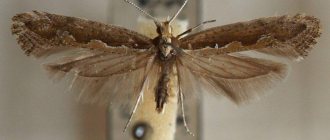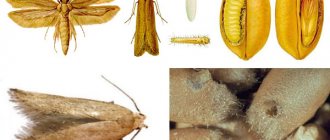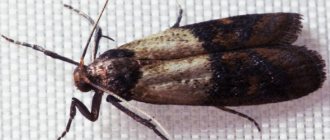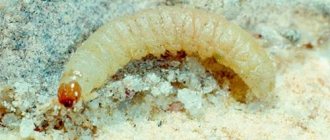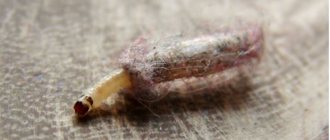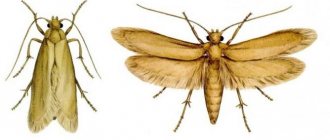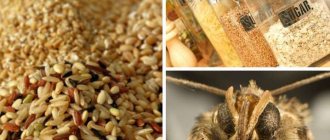Fruit moth: appearance and lifestyle
Fruit moth, appearance
The fruit moth is an unremarkable butterfly: its body is 1 cm long, it is gray in color with dark horizontal stripes.
The insect is nocturnal, so it can often be found in the evening. During the day, fruit moths hide in cabinets and other secluded corners.
The insect's lifespan is only 2-14 days. The female dies after laying her eggs.
She lays eggs in food, from which larvae later hatch and eat the food. Adults do not eat fruit.
Lifestyle and reproduction
It is not difficult for fruit moths to get into an apartment: you can hardly notice its clutches in a package with the coveted dried fruits. In nature, it lives in the tropics, so it definitely won’t fly in through a window or ventilation. But in large warehouses, where the assortment is represented by nuts, apples, and dried fruits, this is a frequent guest.
True, given the huge number of related species, some other species that flew through a window or escaped from neighbors through the ventilation system could easily settle in a bag of dried apples or nuts.
Fruit moths are nocturnal, prefer high humidity - at least 60%, and for unhindered reproduction they need a temperature of 28-30 ° C, then at least 3 populations of insects are hatched per year.
One fruit moth butterfly can lay up to 350 eggs, from which white larvae hatch. Quite often they can be found in dried apricots or figs, but home-dried apples are also susceptible to this scourge.
Where do fruit moths come from in the house?
The easiest and most common way for fruit moths to enter an apartment is through food.
For example, you bought products in a store that contain moths, most often this happens in markets and open pavilions, but it happens that you encounter this insect in supermarkets.
You can also bring moths from your dacha. When harvesting, you need to make sure that there are no moths or their larvae in vegetables and fruits, as they will turn into butterflies and continue to multiply.
Moths can also get into the house through the ventilation system from neighbors or from the basement.
During the warm season, fruit moths can fly into a room through an open window or door.
Protection of dried fruits
If moths have already laid eggs in pieces of fruit, the product will have to be thrown away. It will be necessary to carefully examine the grain, flour, pasta, and cereals standing nearby, since food moths and its varieties can also be found there: flour, fruit, grain. If worms are crawling in some of these products, all these packages must also be thrown away.
If there are few larvae, you can fight for food. Like all insects, moths are afraid of low or high temperatures. Therefore, dried fruits, carefully selecting spoiled slices, need to be dried in an oven heated to 70 degrees for half an hour.
You can also kill moths and their larvae with frost: simply take dried fruits out onto the balcony in winter or leave them in the freezer overnight.
Food moths and their larvae prefer high humidity and warmth. It is difficult to take her out of a home where conditions suitable for her are maintained. The ideal way to get rid of moths is through thorough ventilation, drying corners, and eliminating damp foods.
How to get rid of fruit moths? Ways to fight
Fruit moth (larvae) in dried fruits
The fight against fruit moths is complicated by one important point - you cannot use chemical insecticides. If, for example, you have bed mites in your house, then it is enough to use special chemicals and clean it. But fruit moths live in food, so this method is excluded.
So what should you do to get rid of moths? A good option would be to use special traps and adhesive tapes. They need to be placed in fruit moth habitats: next to cabinets, pantries, shelves where you store grains, dried fruits, and nuts.
Of course, such traps will help reduce the number of insects in the house, but there is no guarantee that you will be able to get rid of them forever.
As soon as you notice that fruit moths have appeared in the house, you need to immediately get rid of all contaminated products. Sort out fruits, vegetables, dried fruits, nuts, grains, etc. Contaminated foods should not be eaten, as they can be dangerous to humans.
All containers in which you stored contaminated food should be washed thoroughly and treated with a vinegar solution. To protect your skin from vinegar burns, you should wear gloves. The solution should be left for at least half an hour. Vinegar has an unpleasant and pungent odor, so after processing you need to ventilate the room well.
Folk remedies for fighting fruit moths
Simple folk remedies can also help in the fight against insects, many of which are found in every home.
The benefits and harms of dried apples for human health, calorie content
Moths do not appear on their own. Most often, you yourself bring it into your home with food; less often, an adult may fly into a window or an open door. As a rule, contamination occurs as a result of violation of the storage conditions of the product, and this can happen both in the factory warehouse and in the store itself.
We invite you to read: Comb for combing out nits: what is it, why is it needed and is it possible to comb out nits with a regular comb?
How can you tell if moths have started to multiply in apples? At the bottom of containers with dried fruits you will probably find not only white worms, but also strange light pellets, as well as traces of a silk cocoon. Food moths can multiply in other places besides feeding, and you will most often find them near cabinets or on the walls of the kitchen.
Many residents often confuse ordinary clothes or fur moths with food moths, which, in turn, also have their own subspecies. Most species of food moths (moths) can be identified by their size and wing patterns.
When folded, the wings of the grain moth seem to be divided into two parts - the upper part, from the thoracic region to the middle of the wings, is light, and the lower part is darker, with a pair of transverse black stripes.
As for the flour moth, its wings are brown with large dark areas (from the side of the head and wing tips), which are bordered by a white line.
The clothes moth is distinguished by its beige color, small size (up to 1 cm), wings tightly pressed to the body and golden or reddish hairs on the head.
Cut the apples into equal slices. This is necessary so that they dry evenly.
These dried fruits consist of a large number of macro- and microelements, various vitamins that the body needs for proper functioning:
- vitamins K, E and B regulate blood circulation;
- ascorbic and other acids contribute to proper brain function;
- Selenium, copper, magnesium, iodine, copper, zinc, manganese, iron and other elements saturate the body and increase immunity.
Dried apples contain the following substances:
- Minerals – magnesium, iron, iodine (improves blood quality, cardiovascular system, metabolism and supports the functioning of the hormonal system).
- Phytoncides (stop the growth of pathogenic bacteria and fungi).
- Tanning (have anti-inflammatory and antibacterial qualities).
- Organic acids - chlorogenic, malic, tartaric, arabic acids (resist infections, regulate acid-base balance).
- Sugar – sucrose, fructose, glucose (restore strength, promote rapid saturation of the body).
- Polysaccharide pectin components (reduce cholesterol levels).
- Flavanoids (resist cell damage by blocking the action of free radicals).
The calorie content of dried fruits is 231 kcal per 100 grams of product.
Using dried apples, a person fills his body with a large number of useful elements, but there are also some contraindications.
Apple dried fruits promote good digestion due to the content of pectin, dietary fiber and fiber. The components of these fruits, proteins, acids, essential oils and phytoncides, improve metabolism and have a beneficial effect on the formation of microflora in the intestines.
How to prevent fruit moths from appearing in the house?
It is always easier to prevent the appearance of an insect in the house than to get rid of it.
There are simple measures that can help significantly reduce the likelihood of fruit moths.
There should be nets on the windows; they will protect you not only from moths, but also from many other types of insects. The ventilation holes should also be covered with a grille, and the smaller the cells, the better.
As soon as you see a fruit moth in the house, you need to kill it immediately so that the insect does not have time to lay eggs and reproduce.
It is better to store food not in a bag, but in special sealed containers. They will not only protect food from the appearance of larvae, but also maintain its freshness.
Food supplies should be checked periodically and any contaminated items should be thrown away.
In warm weather, once a month it will be useful to wipe the inside of all cabinets with a solution of vinegar essence.
Fruit moths are a pest that cause you to throw away food. To protect your home and food from insects, follow simple precautions and, if necessary, apply the tips we described. And then your house will be clean, and all food supplies will be intact.
A small butterfly flying through your kitchen is a serious enough reason to start worrying about the safety of your food. Most often, parasites feed on cereals and grains; moths are also often found in dried fruits. These insects feed while at the caterpillar stage, making small holes in dried fruits and entangling themselves in a silk cocoon.
What do food moths eat?
The food moth itself does not eat anything. Due to the underdevelopment of the food system, it can only consume water or other liquid - which is why it can often be found floating in a glass of water accidentally left on the table. But its larvae, or caterpillars, as they are also called, eat a lot of different foods. Actually, due to this they develop, subsequently passing through the stages of pupa and butterfly.
The nature of the food that species of food moths prefer to include in their “diet” can be guessed from their names given above. But everything is not as simple as it might seem at first glance. For example, the grain moth caterpillar, in addition to cereals and cocoa, will happily taste chocolate, dried fruits, tobacco and even medicinal herbs if it has access to all these delicacies. Other moths of this direction are similarly unpretentious in their preferences.
By the way, in the matter of food damage, the food moth has a competitor in the “face” of the clothes moth, whose caterpillar, in the absence of the usual provisions, will not disdain the gifts of someone else’s cuisine.
External characteristics
If you have observed repeated appearances of butterflies over the course of three weeks, this is evidence that the infestation is quite serious and it is necessary to immediately take steps to eliminate the insects.
The winged moth is no longer capable of causing any harm, since their oral organ is reduced upon reaching sexual maturity. Parasites are their larvae, which, having powerful jaws, feed quite intensively and accumulate energy reserves so that upon reaching the adult stage they have the opportunity to reproduce.
Interesting fact! The absence of a proboscis is due to the fact that, upon reaching sexual maturity, the moth loses not only the ability to feed, but also to digest food. Therefore, they simply do not need this organ.
The caterpillar's head is brown. As a rule, infestation of dried fruits and vegetables with this type of moth will be indicated by small, neat nests and a thin cobweb around them. The larva will be inside the nest.
What does it eat and what is it afraid of?
The kitchen moth is practically omnivorous. She eats not only groceries, but also fresh fruits, and even dried herbs or spices. Adult flying individuals do not feed at all: they lack mouthparts and a digestive system. The threat is posed by food moth larvae, which require a lot of food to pupate.
The following products are at risk:
- Cereals – semolina, rice, millet, buckwheat.
- Pasta.
- Cereals – oat flakes, seeds, bran.
- Dried fruits – prunes, dried apricots, raisins, figs.
- Flour and bakery products: baked goods, cookies, crackers.
- Cocoa and mild spices.
- Nuts – hazelnuts, almonds, cashews.
- Sugar.
Food moths cannot tolerate the smell of citrus fruits, lavender, tansy, wormwood, rosemary, dill, and cloves. Therefore, for preventative purposes, you can hang dried bouquets of herbs in the kitchen or use essential oils - to scent the air, wipe cabinets, add to water when wet cleaning.
Stages of transformation into food moth from eggs.
Fighting methods
To destroy food moths, first of all, you should pay attention to gentle methods. It is not recommended to immediately use insecticides in the kitchen, as there is a possibility of the chemical getting on food. First, try traditional methods that can not only get rid of pests, but also prevent their reappearance.
Heat treatment
Once you have discarded all contaminated dried fruit, the remaining fruit can be heated at relatively high temperatures. To carry out this operation, the fruits are freed from packaging and laid out on a baking sheet. Set the temperature in the oven to no less than 50°C and no more than 70°C and heat the product for 3 hours.
At the end of the procedure, the fruit must be placed in glass containers with a hermetically sealed lid and put in the refrigerator or on a shelf in a cabinet. When you notice that adults stop appearing, the products can be returned to their permanent storage location.
Using improvised means
For the second method you will need:
- soap solution;
- table vinegar;
- lemon, eucalyptus or peppermint essential oil;
- Bay leaf.
The process sequence is as follows:
- completely empty wall cabinets, bedside tables and pantry of food and any objects;
- using a small vacuum cleaner attachment, treat the interior surfaces of the cabinets;
- Using a soft sponge soaked in a hot soapy solution, wipe the shelves, doors, hinges and corners of the furniture;
- containers intended for dried fruits must also be treated with soap and water;
- dry everything thoroughly and wipe with vinegar, to which you should first add a few drops of essential oil;
- Place a bay leaf on the bottom of each container.
Prevention
Having completely gotten rid of moths in dried fruits, you need to think about preventive measures. To prevent the parasite from returning to your kitchen, you can do the following:
- try to constantly maintain perfect cleanliness in the kitchen, which will prevent the appearance of not only moths, but also other insects;
- store food only in closed glass containers;
- it is better to cover hoods and vents with mesh to avoid the penetration of parasites from neighboring apartments;
- When you come home from the store, always check your food products - sort through dried fruits, add grains.
Now you know how to recognize fruit moths, remove them and prevent their reappearance. Remember that food parasites will only fly in the kitchen. If you notice small butterflies in the closet, then this is a completely different type of pest, which you can learn about from other articles on our website. For example, if you want to protect your winter wardrobe from small pests, we recommend reading the article: What means can you use to protect your fur coat from moths?
Young mothers and grandmothers prefer compotes, for the preparation of which dried fruits are used, rather than packaged and bottled drinks. After all, store-bought juices contain a huge amount of preservatives and various dyes. Therefore, in villages, apricots, as well as pears and apples are constantly dried. If you do not follow the storage rules, then fruit moths appear over time. You can cope with it if you start fighting immediately.
How to prevent damage
It's a shame when a lot of food goes to waste. To prevent this from happening, you must follow a few simple rules. Below are the rules by following which you can get rid of food parasites and avoid unexpected losses:
- Store products in tightly closed jars.
- Prevent fruit moths from appearing in your home. Destroy physically!
- Place pots of geraniums on the windows. The essential oils released by this plant repel these insects.
- Periodically check the food in the kitchen and pantry. Contaminated products are a source of parasite spread. Such products are simply thrown away.
- Wipe shelves with vinegar solution. Vinegar destroys the eggs of this insect. As a result, the probability of larvae appearing drops to zero.
The fruit moth reproduces very well: it lays many eggs, the larvae grow quickly and new individuals emerge from them.
Features of the insect
It is difficult to quickly detect that moths have infested dried fruits. After all, only fully formed insects move around the kitchen or utility room, and they practically do not feed on anything. The imago looks for a secluded place to lay eggs. Larvae emerge from the eggs and spoil dried fruits.
In order to distinguish this type of pest, you need to pay attention to the wings. They have peculiar stripes on them. The length of the insect body is 9–10 mm. The larvae look like small worms. During development, the larvae are in a cocoon covered with cobwebs and mucus.
How to protect yourself from moths
To prevent pests from infesting dried fruits and other products that are in the house, it is necessary to inspect cereals and dried apples before purchasing. There should be no small holes or other defects on the surface of dried pears or apricots. After all, the larvae form holes to get inside.
Ventilation holes and vents are equipped with fine-mesh mesh, which does not prevent air penetration, but traps pests. Periodically, remove the mesh from the ventilation hole and windows in order to wash it. For washing, use a solution including water and vinegar. Such protection is removed in winter, since insects do not fly at this time of year. All corners and joints that are present in the room are treated with protective compounds and carefully checked.
Knowing exactly how to protect food and dried fruits from food moths, you can eliminate excessive costs. After all, it is easier to carry out preventive measures than to deal with the destruction of pests in the future.
How to store dried fruits
Knowing how to store dried fruits and dried apricots to prevent moths, you can save money and protect your home from pests. Do not place cereals, flour and other products in one place. Plastic bags are not used for storage, as condensation accumulates in them and mold appears over time. The larvae easily gnaw through polyethylene and spoil the cereals or dried apples contained in it.
To prevent moths from appearing in dried fruits, you must follow these rules:
- Newly purchased cereals and flour are placed separately. Responsible housewives carry out heat treatment or blow cold air.
- Dried apricots, dried plums and apples are placed in containers made of metal, glass or food-grade plastic. If a metal container is used, then its bottom is covered with thick paper.
- The container is periodically inspected to increase the storage period of dried fruits and to protect them from moths.
During the warm season, products are stored in wooden containers. This is necessary so that the dried apples and pears are exposed to air and dried. After all, excess moisture can provoke the formation of mold or mildew. Experienced housewives and summer residents know exactly what to do with dried apples and pears. After all, they make huge reserves every year.
How to fight moths
Before getting rid of fruit moths, you need to study popular methods. Experts do not recommend using chemicals, as they contain toxic components. You need to start by checking the kitchen units and cabinets in which the cereals are located. Once contaminated products have been disposed of, all surfaces are washed and cleaned. A soap solution and clean running water are suitable for these purposes.
The following products are suitable for controlling fruit stripe moths:
- Peels from orange, lemon or tangerine.
- Sachets that are filled with certain spices. Pests do not tolerate cinnamon, pepper, and coriander well.
- Pre-dried bay leaves or twigs. The market also sells bags filled with these plants.
- Bags of certain herbs. Plants such as mint, lemon balm and lavender have a rich aroma.
- In the kitchen set there are containers filled with salt. With their help, they get rid of excess moisture.
The above folk remedies help repel pests, so they are used when carrying out preventive measures. To control larvae, caterpillars and adults, you can use traps, chemicals or products. Those places that are treated with special means must be cleaned and washed. Such actions help prevent contact between food and pesticides.
Destruction of moths
Methods for killing moths
The moth is not distinguished by its quick reaction or strong flight abilities. It's easy to slam him. But there is no guarantee that this is the only or last butterfly in the room, so you should play it safe and use effective moth repellents in the apartment and in the kitchen in particular.
- Sticky tapes are hung around the kitchen, anti-moth tablets and special traps are used in cabinets.
- Among the folk remedies, herbs such as lavender, peppermint, chamomile, and geranium will help repel the pest. These plants repel moths with their scent. Orange peels and garlic are also excellent repellents.
- Ventilating the kitchen for 20 minutes every evening during cold periods reduces the activity of moths and creates unfavorable living conditions for them.
- In case of severe infestation of the premises, aerosols and moth sprays are used. Initially, they carry out cleaning to destroy the larvae, wipe down the cabinets, and hide the food in airtight containers. Disinsection is carried out. Use any insecticidal agent - Raptor, Raid, Antimol, Clean House, Dichlorvos. After 20 minutes, ventilate, carry out wet cleaning by adding baking soda and laundry soap to the water. An alkaline environment completely neutralizes the effect of the insecticide.


